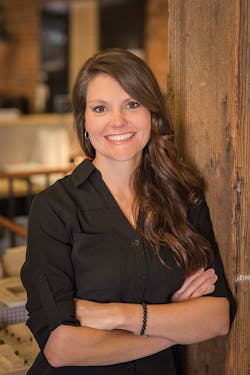As the lines blur between work and home, companies are following suit by embracing comfort and beauty—hallmarks of residential design—to make workplaces more attractive to a competitive
pool of talent. Here, Katie Cavallo, IIDA, interior designer at SHEARS ADKINS ROCKMORE; and Amanda Loper, AIA, LEED AP, principal at David Baker Architects, discuss how residential design found its way into the office, reflecting on why comfort and aesthetics matter in the workplace, and why it’s here to stay.
bringing down the walls
Amanda Loper: Looking back, one of the key trends across design is that personal space is getting smaller while shared space is getting bigger. In mixed-use residential projects, units are shrinking while common spaces are gaining prominence, and the same has happened with workplaces—cubicles and offices are things of the past. With technology, employees don’t need as much space to work, and culturally, people want to be together, even when they are working alone.
Katie Cavallo: People want to work the way they live, which breaks down the barriers of formality in the workplace. The real-estate footprint has become smaller because spaces have become multifunctional and more open. I find people use examples of how they live or travel to describe what they prefer in a workplace.
al: People no longer compartmentalize their lives. It’s common for employees to want to work in spaces that are more attractive, and in interesting, mixed-use downtown areas that offer walkable environments. The old school thinking that you drive up to a building in an industrial park to work in a high-walled cubicle is not appealing to younger generations. It’s not that the office needs to be casual, per se, but people need to feel comfortable. It’s the little touches—soft materials, natural light, plants—that blur the lines between residential and workplace design.
evolving employee expectations
KC: People are more educated on what is visually pleasing. We’re surrounded by thoughtful design—graphic design, fashion, websites, products. In general, people have higher expectations for the spaces where they live and work. They want their environments to be attractive and comfortable. It is becoming instinctive for non-designers to know when something doesn’t look “right.”
al: Beauty makes us feel good. If we see something as beautiful, there’s a human connection. Most people don’t respond positively to sterile, corporate environments. The talent pool has become more competitive for companies, and if your office is aesthetically pleasing, you’re more likely to attract and retain employees.
purposeful and functional
KC: The key to creating appealing workplaces is [a distinctive design that] holds an element of surprise. Since we need office environments to be multifunctional, we must provide comfortable spaces that are purposeful and respond to the audience.
al: We are having the same conversations with mixed-use residential, hospitality, and corporate clients. They’re all thinking about the same elements: communal places to gather, eat, and meet; private areas for focused work; health and wellness; accessibility to Wi-Fi; and comfortable places where people can just hang out on their laptops. The purposeful use of space is paramount to all of these conversations.
KC: Function is what separates design movements from passing fads. For example, just because you have a ping-pong table at home doesn’t mean
it belongs at work. But elements that combine comfort and beauty with functionality—like natural light, access to nature, and soft material—are always going to be sought after in residential and workplace design.
workplace design, leveraged
Good workplace design isn’t just a matter of what looks and feels appealing
to employees—there is an undeniable business case that good design affects employee satisfaction and engagement. “Design Leveraged, Volume 2,” a joint publication of IIDA and the Business and Institutional Furniture Manufacturers Association (BIFMA), explores this link with hard data, statistical analysis, and case studies. Visit iida.org to learn more about “Design Leveraged” and IIDA thought-leadership publications.
